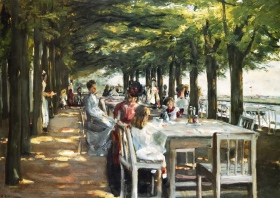Literature, Art, Myths & Legends
Legends of Wild Swans
Author: Tala Bar
LEGENDS OF WILD SWANS
The Wild Swans at Coole
W.B.Yeats
The trees are in their autumn beauty,
The woodland paths are dry,
Under the October twilight the water
Mirrors a clear sky;
Upon the brimming water among the stones
Are nine-and-fifty swans.
...
But now they drift on the still water,
Mysterious, beautiful;
Among what rushes will they build,
By what lake's edge or pool
Delight men's eyes when I awake some day
To find they have flown away? (s. link).
One of the best known swan stories is Hans Christian Andersen’s tale of The Wild Swans (s. link below). In it, a widower king had eleven sons and one daughter, Eliza. He marries a wicked sorceress who resents the children, and turns the boys into swans who fly away. The Princess goes out to look for them, and on the way she cries so much she creates a lake of tears. On the bank of this lake she finds her Swan brothers, and a fairy appearing in her dream tells Eliza the secret of their release: if she gathers enough nettles to make eleven shirts, when they wear the shirts they will be released from the magic. The girl collects the nettles, and sits in a cave in a forest to do her sewing. (It is clear that the cave in the forest, as well as the young men turned into swans, transport the girl and her brother to a place outside the realistic, civilized world into the realm of Nature and myth). Eliza is found by a young king who had been hunting; he falls in love with her beauty and takes her to his palace as his wife – nettles and all. During her stay in the palace, many jealous people tell the king wicked stories about her, calling her a witch, and in the end he is forced to burn her on the stake. While Eliza continues, even in prison, to sew her brothers’ shirts, they come to visit her in the shape of swans. At last, when she is taken out to be burned, they fly over her; she throws the finished shirts at them, and they return to their forms of eleven princess, except the youngest whose shirt is not finished and he retains one wing instead of an arm – thus retaining some remnant of the world of Nature within civilization.
Similar stories appear in Grimm with some variations, although in one story the girl has only six brothers instead of eleven. In all these cases, the swans are male; the situation is reverse, however, in Chaikovski’s beautiful music to the ballet Swan Lake (s. link below). That story tells of a wicked sorcerer, who turned Princess Odette into a white swan; all day she flies in the company of her girl swans, and only at night she lands on the bank of a lake and returns to her form as a woman. (The lake, by the way, was formed from the mother’s tears shed over her daughter’s fate; we have here a double figure of mother/daughter of a Water goddess). The story says that only if a young virgin man swears eternal faith to her love and marries her, she will be released from the magic; but if the prince betrays his oath, she will dies. Prince Siegfried of the story indeed falls in love with the Swan princess, but the sorcerer entices him to betray her by making him show his love to the dark, artificial figure of Odile he himself had created. Odile, actually, beside her opposite color, is the splitting image of Odette (here is a double image of white/black, light/darkness, or good/evil). After the betrayal is discovered, Odette prepares to die; but then the Prince comes and tries to save her. His love releases her from the magic, but they drown together in the lake.
Details shared by the two stories are turning humans into swans by sorcery; the hunting king/prince; and the lake of tears created by a female. The main differences between the two are the genders of the bewitcher and the humans turning into swans. It may be noted that both Eliza and Siegfried are names taken from Germanic mythology; the lake created by a female’s tears makes her a Water goddess. It may be assumed, then, that both fairy tales are based on much earlier European mythology connected with swans. In order to understand their basic meaning, then, it may be interesting to turn to such ancient myths.
It seems that many similar stories are common all over the continent, wherever swans appear. Such tales are known from Sweden, Germany, Romania and others, (similar to such where the swans are replaced by seal, bears or other animals), that in some cases shed their outer skin and take human shape; it is significant that in some of these stories, like in Andersen’s and Chaikobski’s, these people are bewitched, but in others they do it of their own free will. In an Online site called Swan Maiden (s. link below), a hunter encounters a swan or a group of swans, fly onto the bank of a lake; they shed their feather cloaks, turn into human maidens and go swimming. The hunter snatches one of the cloaks and hides it, thus trapping her owner to come and be his wife. They live together until she finds her cloak again and flies away. The stories end in various ways, from tragedy to happy ever after.
It is highly significant that all these stories involve females as swans, not males. But an old Irish stories tells it in a different way (s. link below). Angus son of the Dagda falls in love with a swan-girl who appeared in his dream. Afterward, he meets a group of 150 swans, flying in pairs, which are tied together with a chain of silver; but his girl wears a crown and a chain of gold. When Angus calls out to that particular swan, she leaves the group, turns him into a swan and they fly away together, tied with a golden chair. It is clear here that the swan maiden has her own power to change at will, and is bound by any male sorcerer; what is more – she has the power to change her lover as well into a swan, which makes her a veritable Swan goddess. This is a hint at the initial function of the swan in European mythology.
***
It seems that, in the Hindu-European tradition, there a number of Swan goddesses. Some of these goddesses were connected with death, and others with some qualities of the Underworld (where dead people go), like wisdom and prophecy. Robert Graves has defined the swan as a bird of Death, and the three Greek figures of Graeae, or Gray Ones, clearly demonstrate this idea: they were described as "fair-faced and swan-like". They had gray hair from birth and shared one eye and one tooth which, according to Graves, they used for prophecy. Their genealogy goes back to the early descendants of the Earth and Sea, and their separate names were Enyo (“horror”), Deino (“Dread”), and Pemphredo (“Alarm”).
A Celtic Swan goddess was Brigit, to whom this bird was sacred; she was in charge of the Underworld qualities of Wisdom and Crafts. In Hindu mythology, the swan was sacred to Saraswati, goddess Wisdom and Learning, who sat on a throne made of two swans.
Other deities are connected with the swan through its shining white beauty. Such figures are Greek Aphrodite and Roman Venus, to whom the swan was sacred. But another symbol of beauty, much more complicated to these Love goddesses, takes this connection much further. That was Helen, who was the daughter of Leda and the Swan – or, in another interpretation, Leda as a Swan; after all, she was the one who laid the Swan egg, which the two pairs of twins sprung out: Helen and Clytemnestra; Castor and Polydeuces (known as Pollux) – the Dioscuri (“twins”) who “embodied the two halves of the year”.
The multiplicity of the swan’s image – Death, Wisdom, Motherhood, Beauty and Love –
is well represented in the figure of Helen, and is connected with another trait of that bird. The swan is a migratory bird, as is well expressed in both Yates’ poem and in Lemke’s painting. It is actually seen not only in autumn and the dying of the year – hence its connection with Death, but also in springtime, connecting him with idea of revival. It is, then, a symbol of the Great Nature Goddess who was in charge of the yearly dying and resurrection.
According to a site called Goddesses and Priestesses Connected with Hera (s. link below), Helen's name means “bright one, light, Sun, fair;” it refers to her as a Harvest goddess, when the Sun is at its peak (in the Mediterranean area). Another title of Helen’s is Dendritus – “she of the trees”, referring to her as a Fertility goddess in charge of fruit trees; her tree festival was celebrated annually in the isle of Platanistas, where she was worshipped until late 19th cent.. By another title, Rhigidenes, meaning “rigidity”, Helen was in charge of death in various forms, including the orgasmic death of the penis. This combination of characteristics suggests she may have begun as a Pillar Goddess like Asherah or Aphrodite, worshipped with ecstatic dance and sexual rites.
This idea is the basis of the theory of the swan being a symbol of the dying year in autumn, that comes after Midsummer, the peak of the sun and harvest time, to be resurrected again in spring. The Dioscuri, swan born, were kings of the two halves of the year, annually dying and resurrected. Their mother, then, either Leda or in her embodiment as Helen, was actually the Great Mother Goddess, in charge of Life and Death, symbolized by the swan, appearing regularly in Spring and Autumn. Graves connects this myth in his book The Greek Myths with the idea that “at midsummer, they (the swans) flew north to unknown breeding grounds, supposedly taking the dead king’s soul with them.”
The swan appears also as Laima, a Lithuanian Mother Goddess (who is also represented as a Goddess of Fate, determining the life and death course of human beings), who was in charge of “blessing, unity, destiny, love, luck and magic”, according to the site by her name. Her symbol is said to be a wreath, and her totem is the swan. As a Mother, it may be noted that the Hindu god Brahma hatched from a swan’s egg. The swan was also sacred to the Christian Mary, Mother of Jesus. Male individuals could become swans only by her grace, either when she grants them her love as a maiden, or when she takes their souls away in death. Such Death goddesses were the Valkyries, who flew in the shape of swans when looking in the battlefield for warriors who died bravely, to take their souls as a reward to the Paradise of Valhalla.
However, Death goddesses of ancient myths turned into wicked witches in fairy tales. Thus, it was the same goddess in Andersen’s tale who, as the Sorceress Queen turned the boys into swans, and as the Maiden turned them back into humans; the young fairy in the story is another appearance of the Princess herself. Such an equation of Old Witch = Young Maiden appears in Chaucer’s poem The Knight’s Tale.
The swan, then, is one of the manifestations of the Goddess as a Maiden, Mother, and Death Crone, who causes her male charge to be born, to grow to a young handsome hunter, to make love, to die and descend to the Underworld, and finally to come back to life and begin the cycle all over again, as a symbol for the ever changing and circulating year. But the power of that goddess was taken from her with changes of social structure by “a wicked sorcerer”, who put himself in charge of her and of everything on earth, to destroy at will, as we can see in Chaikovski’s magnificent ballet.
http://www.northendgallery.ca/autumnswans.html - Autumn swans
http://www.aaronshep.com/stories/064.html - Lohengrin
http://hca.gilead.org.il/wild_swa.html - Hans Christian Andersen’s The Wild Swans
http://www.abt.org/education/archive/ballets/swan_lake.html - Chaikovski’s Swan Lake
http://en.wikipedia.org/wiki/Image:Mute.swan.cygnets.750pix.jpg - About swans
http://en.wikipedia.org/wiki/Swan - Swans in human culture, wikipedia
http://www.pitt.edu/~dash/swan.html - Swan Maidens tales
http://www.swansongs.org/swanmyths.htm - Irish myths and legends
http://www.swansongs.org/swanmyths.htm - Swans in shamanism
http://www.hindudevotion.com/saraswati.html - Hindu Saraswati
http://www.artofeurope.com/yeats/yea4.htm - WB Yeats’s poetry
http://www.moonspeaker.ca/hera/helen.html - Helen
http://findagoddess.com/display.php?HERNAME=Laima - Laima
http://www.pantheon.org/articles/g/graeae.html - The three Gray Ones
About the Author:
I live in Israel and I hold an M.Phil. Degree in literature from the London University, having studied both Hebrew and English languages and literature. I taught these subjects before I became a full time writer. My main interest is mythology, but I write also fantasy and science fiction stories, novellas and books, and had many of them published in print and on the Net, both in Hebrew and English. Among works of mine published on the Net and in print are Minstrel in the Forest and The Myth of Tristan and Isolde. editor@thewriterseyemagazine
Article Source: ArticlesBase.com - Legends of Wild Swans

_(2).jpg)


